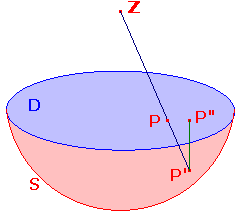The set is D, as for the poincare model.
It is defined by a bijection k from D, regarded as the set of the poincare model,
to D, regarded as the set of our new model.
Regard D as lying on the xy-plane in three-dimensional space.
Let S denote the lower half of the sphere x2+y2+z2 = 1,
The map k is defined in two stages:
- project each point P on D stereographically from Z(0,0,1) onto S,
i.e. map P to P', the point where the line ZP cuts S. - project P' orthogonally onto D, i.e. to the point P" on D lying
vertically above P".
a two-dimensional map, i.e. we suppress the z-coordinate which is always 0.
As above, the group is kH(2)k-1, though it is difficult to describe explicitly.
The k-lines are the subsets of the form k(H), where H is an h-line. We find that
these have a particularly simple form - in some ways, nicer than the h-lines.
The Poincare-Klein Map
intersection of the euclidean line AB with D.
Thus, the k-lines are the intersections of D with
euclidean lines - i.e. are
euclidean segments. A number of properties of hyperbolic geometry
are easy to prove using this model. For example
- if P and Q lie in D, then there is a unique k-line throgh P and Q.
- two k-lines meet in at most one point.
Pappus's Theorem in Hyperbolic Geometry
Suppose that A,B,C lie on a hyperbolic line L, and A',B',C' on a hyperbolic line L'.
If the hyperbolic lines AB',A'B meet in P, BC',B'C in Q and CA',C'A in R, then the
points P,Q,R are collinear.
In the klein model, the hyperbolic lines are euclidean segments. The euclidean
version of Pappus's Theorem applies to the diagram, and this then proves the
hyperbolic version!

This model has as its set a certain surface in three-dimensional space.
A point (x,y,z) on the hyperboloid x2+y2-z2=-1
has z2 = 1+x2+y2 ≥ 1,
so z ≥ 1 or z ≤ -1. Thus the hyperboloid consists of two sheets on either
side of the xy-plane. We take as our set H the sheet with z ≥ 1.
This is discussed further in the hyperboloid page.
We map D to H by stereographic projection from Z'(0,0,-1). This gives
the map m. The proof of the following result shows that m is actually a
bijection between the sets.
The Poincare-Minkowski Map
m(x,y) = (2x/(1-x2-y2),2y/(1-x2-y2),
(1+x2+y2)/(1-x2-y2)).
m-1(x,y,(1+x2+y2)½) =
(x/(1+(1+x2+y2)½),
y/(1+(1+x2+y2)½).
proof
The minkowski model has the set H. The m-lines are the
intersections of H
with planes through the origin.
This model is related to special relativity. It is also of considerable significance
in geometry. The group for the minkowski model is isomorphic to a subgroup
of the projective group P(2). This shows that hyperbolic geometry is related
to projective geometry. Unfortunately, the proof of the isomorphism is rather
complicated. By the above theory the group of the minkowski model is mH(2)m-1.
The Hyperbolic-Projective Theorem
If m is the bijection from the hyperbolic model to the minkowski model,
and K the projective conic with equation
x2+y2-z2 = 0, then the group
mH(2)m-1 is isomorphic to the projective symmetry group of K.